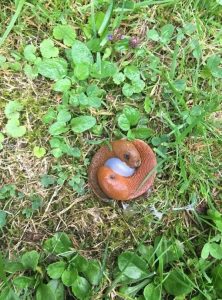Speculation spread across the internet like wildfire.
What were these strange, glistening shapes twisting together on the forest floor? Were they mysterious sea creatures washed inland? Some kind of exotic amphibians never before documented?
The truth turned out to be far more ordinary—yet infinitely more fascinating.
They were Arion rufus, commonly known as red slugs, captured mid-mating in an extraordinarily rare and intimate moment that few humans ever witness.
These striking slugs are hermaphrodites, possessing both male and female reproductive organs. Their mating ritual is not quick or casual—it’s an intricate, slow-motion performance of biological coordination. For hours, two red slugs engage in what could best be described as a slimy but graceful dance of mutual fertilization. Their movements are deliberate, synchronized, and strangely beautiful, representing one of nature’s quiet marvels that often goes unseen.
In the grand scheme of nature, red slugs rarely get the spotlight. They’re often dismissed as garden pests or ignored entirely by casual observers. But in truth, these creatures play an essential ecological role. They help decompose decaying organic matter, breaking down leaves, dead plants, and other debris. In doing so, they return valuable nutrients to the soil—fueling the life cycle of forests, gardens, and meadows across Europe and North America.

Their work is slow and hidden, yet profoundly important. Without decomposers like red slugs, ecosystems would be overwhelmed with organic waste. These humble creatures are the recyclers of the natural world, quietly maintaining the balance that allows new growth to thrive.
What made this particular moment special wasn’t only the rare biology on display—it was the shared sense of curiosity and wonder it ignited. Within hours of being posted on Reddit, a simple video clip of two slugs became a viral sensation. Viewers around the world, from scientists to schoolchildren, were mesmerized.
Comment sections filled with questions, theories, and genuine fascination. Some were amazed by the biological process itself; others simply marveled that something so extraordinary could happen in such an ordinary setting—a damp patch of forest floor, somewhere in the quiet corners of nature.
That online conversation soon evolved into an unexpected global learning moment. People who had never given slugs a second thought found themselves diving into articles, documentaries, and scientific discussions about the natural world. The internet, often accused of trivial distractions, had for a brief moment become a bridge between curiosity and science.
And that is perhaps the most remarkable part of this entire event.
Nature doesn’t always reveal its wonders in grand, cinematic moments. Often, its most astonishing stories unfold silently, right under our noses—beneath fallen leaves, behind moss-covered stones, or in the quiet rhythm of two red slugs intertwining on a forest floor.
This viral encounter is a gentle reminder that the world’s most incredible stories are happening around us all the time, whether we notice them or not. All it takes is a moment of curiosity—a willingness to look closer—to uncover the extraordinary in the seemingly ordinary.


